h8dutility woes (again)
smb...@gmail.com
norberto.collado koyado.com
The “XH” command works.
Per Douglas: The missing step for using the XH command is to replace H89LDR3.BIN with the one from the URL that I posted.
https://github.com/durgadas311/MmsCpm3/blob/master/rom/newmon/src/h8dutil/bin/h89ldr3.bin.
I used the vh8dutil file instead.
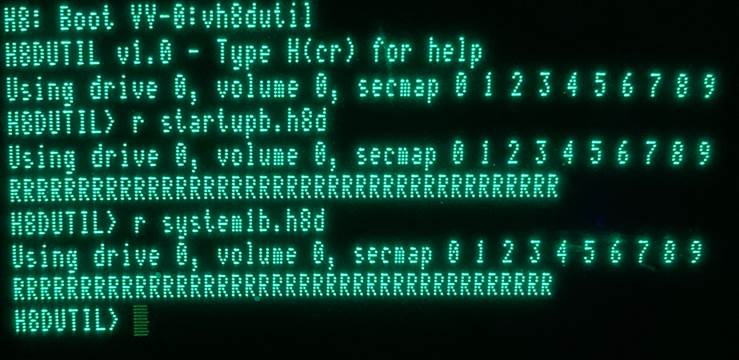
Norberto
--
You received this message because you are subscribed to the Google Groups "SEBHC" group.
To unsubscribe from this group and stop receiving emails from it, send an email to
sebhc+un...@googlegroups.com.
To view this discussion on the web visit
https://groups.google.com/d/msgid/sebhc/de5a40f5-ae75-4320-b12f-870b89198864n%40googlegroups.com.
norberto.collado koyado.com
For the vh8dutil.sys file, I just copy the H8D file to the VDIP1 USB flash drive using my laptop. Rename to 8 chars or less such as “HDOS2.H8D”.
Then at the Z80 console I just boot from the VDIP1 the vh8dutil file, then type r HDOS2.H8D and done. It will be looking for the H17 controller to complete such operation.
No need to use the laptop to do the same thing on the H17 controller.
Norberto
smb...@gmail.com
norberto.collado koyado.com
For sure you will love the USB VDIP1 vh8dutil file….
To view this discussion on the web visit https://groups.google.com/d/msgid/sebhc/3f338d8b-d96e-42bf-b781-faefcb20180bn%40googlegroups.com.
glenn.f...@gmail.com
There’s an “off by 3” addressing problem with the H89LDR3.BIN files on the versions on the SEBHC site. the way the software works this will cause failure. we need to fix this as multiple folks have had this problem.
I’ll take a look and work with Les to make any necessary updates. Watch for follow up, meanwhile I think if you make the replacement with the version on Doug’s site you can get things working. This seems like a configuration control issue of some sort…
- Glenn
From: se...@googlegroups.com <se...@googlegroups.com> On Behalf Of smb...@gmail.com
Sent: Tuesday, February 14, 2023 2:27 AM
To: SEBHC <se...@googlegroups.com>
Subject: Re: [sebhc] h8dutility woes (again)
Thanks Norberto, I'll give XH a shot this weekend with the file you linked.
To view this discussion on the web visit https://groups.google.com/d/msgid/sebhc/3f338d8b-d96e-42bf-b781-faefcb20180bn%40googlegroups.com.
smb...@gmail.com
dwight
Sent: Tuesday, February 14, 2023 10:45 AM
smb...@gmail.com
smb...@gmail.com
norberto.collado koyado.com
Scott,
I can try tomorrow on my system using the Z80 V4 board. Send me some steps to reproduce here and the H8D file to use. I will be using the Z80 on-board serial port. I’m not using the H8-4 anymore.
Thanks,
Norberto
To view this discussion on the web visit https://groups.google.com/d/msgid/sebhc/cf9c8d6d-4ea9-47e7-a953-807667ef97c1n%40googlegroups.com.
norberto.collado koyado.com
Can you remove the H8-4 board and use the Z80 v4 on-board serial port instead and try again? As you mentioned that works with the 8080A, it looks like a jumper setup on the Z80 v4 board..
Removing the H8-4 will give me information on what might be the issue.
Norberto
To view this discussion on the web visit https://groups.google.com/d/msgid/sebhc/SN6PR01MB38558CB5CC12F14CF6171320F7A39%40SN6PR01MB3855.prod.exchangelabs.com.
Scott Baker
To view this discussion on the web visit https://groups.google.com/d/msgid/sebhc/SN6PR01MB3855C096F3C56AE8A1ABABE6F7A39%40SN6PR01MB3855.prod.exchangelabs.com.
glenn.f...@gmail.com
This may be the same issue that Joe Travis recently had, and that I encountered some time ago. The “Dwight Elvey” H8 loader was originally designed/tested (nearly 20 years ago!) on 8080 CPU H8 systems (H8-5) and the H89. The H89 code (8250 UART) also works fine on the H8 with H8-4/8080 CPU. On Z80-based H8 systems there appears to be enough lag due to the 2ms/Front Panel ISR that occasionally bytes can be dropped on the receiving end, since the serial handler uses task-time polling (not interrupt-driven). Some time ago I developed a fix for this by turning off the front panel refresh while the program is receiving data.
I’ve also been having a sidebar with Douglas on his H8DUtility support in the Rev 4 Z80 ROM. it seems there are a few things we need to do to synchronize all these efforts and get to the point where this works reliably on all configurations. May take a bit to get there… stay tuned.
To view this discussion on the web visit https://groups.google.com/d/msgid/sebhc/cf9c8d6d-4ea9-47e7-a953-807667ef97c1n%40googlegroups.com.
norberto.collado koyado.com
BTW, Is it possible to use an 8250 instead of a 16550? Yes you can use an 8250 instead. I will double check tonight.
To view this discussion on the web visit https://groups.google.com/d/msgid/sebhc/CA%2B8qVMMMsdwBnbSvC2m-ORM7eM7M7-pfWjnXTP79XGDxr6uRog%40mail.gmail.com.
Joseph Travis
To view this discussion on the web visit https://groups.google.com/d/msgid/sebhc/23acebe6-5f49-493b-b7f7-ece3b5353e7cn%40googlegroups.com.
Les Bird
Douglas Miller
Opto-isolators are usually intended for current-loop. Is anyone
actually running current-loop? I'm not clear why anyone would be
trying to use opt-isolators for +/-12V RS-232.
To view this discussion on the web visit https://groups.google.com/d/msgid/sebhc/189fdb22-2271-4f08-b48f-acb97551f50en%40googlegroups.com.
Glenn Roberts
To view this discussion on the web visit https://groups.google.com/d/msgid/sebhc/189fdb22-2271-4f08-b48f-acb97551f50en%40googlegroups.com.
norberto.collado koyado.com
I couldn’t resist and did a quick test on the Z80 V4 board as a console. It worked fine and booted HDOS2.0 without any issues. I kept the circuit backwards compatible.
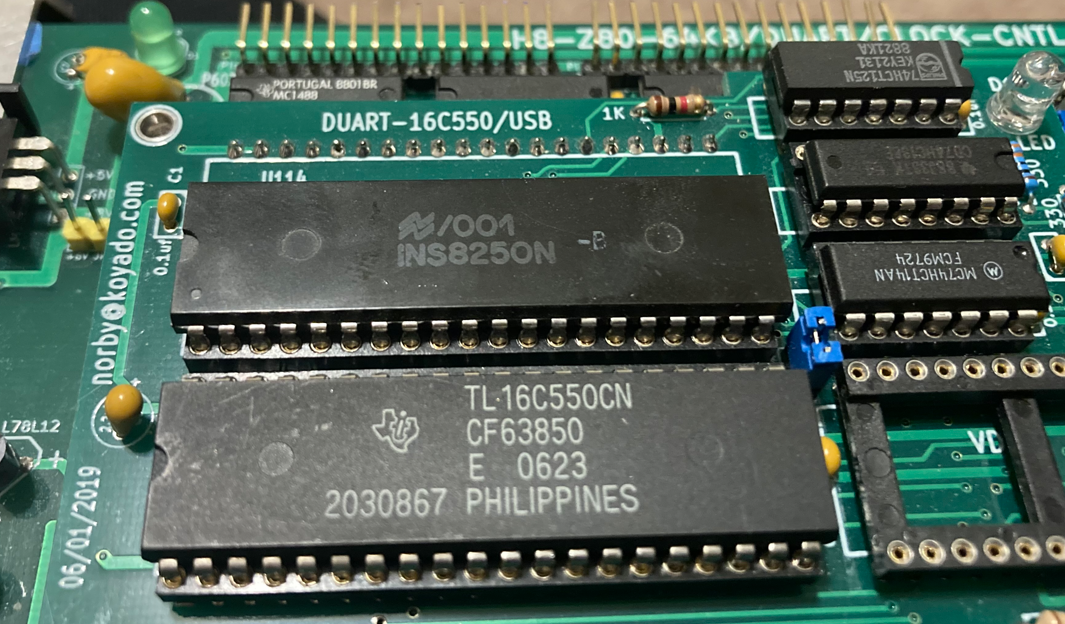
Norberto
To view this discussion on the web visit https://groups.google.com/d/msgid/sebhc/SN6PR01MB3855440C25231C692CB79C11F7A39%40SN6PR01MB3855.prod.exchangelabs.com.
norberto.collado koyado.com
Sent: Wednesday, February 15, 2023 7:13:43 AM
To: se...@googlegroups.com <se...@googlegroups.com>
Steven Shumaker
Yes! I'd like to try connecting a modern setup to ASR33s for
"classic" I/O. It's doable with convertors but native would be
nice!
Steve
To view this discussion on the web visit https://groups.google.com/d/msgid/sebhc/361311e4-5738-f479-43f5-2aa8c3b65946%40gmail.com.
glenn.f...@gmail.com
So I’m investigating all of the ways we use the H8DUtility and I can’t seem to get anything to work with the “XH” command in the new ROM. I have substituted in the h89ldr3.bin image on Douglas’ site (below). I’ve tried both Les’ older H8DUtilitiy (v 2.2) and his new V3. When I get to the point where the .BIN gets downloaded that appears to partially work, at least something happens – the H17 disk drive motor comes on, head loads, and activity LED lights, but then nothing further. This is with the 2.0(beta30) ROM. Since RTM/0 is not supported by the ROM I can’t break out and see where the code is hanging, nor can I monitor the Program Counter as the ROM takes over the LED display.
Norberto: do you have this working? what are you using for the PC client?
Doug has pointed me to the ROM and h89ldr3 code so I’ll start digging there…
- Glenn
From: se...@googlegroups.com <se...@googlegroups.com> On Behalf Of norberto.collado koyado.com
Sent: Tuesday, February 14, 2023 2:09 AM
To: se...@googlegroups.com
Subject: RE: [sebhc] h8dutility woes (again)
The “XH” command works.
To view this discussion on the web visit https://groups.google.com/d/msgid/sebhc/SN6PR01MB3855940679AC5F9A9984B419F7A29%40SN6PR01MB3855.prod.exchangelabs.com.
Douglas Miller
RTM/0 should be working, but that requires interrupts to be
enabled. So, can't always guarantee it will work - especially with
something like this.
To view this discussion on the web visit https://groups.google.com/d/msgid/sebhc/05f101d94191%247b9dc1e0%2472d945a0%24%40gmail.com.
norberto.collado koyado.com
Sent: Wednesday, February 15, 2023 3:26:38 PM
To: se...@googlegroups.com <se...@googlegroups.com>
Subject: Re: [sebhc] h8dutility woes (again)
RTM/0 should be working, but that requires interrupts to be enabled. So, can't always guarantee it will work - especially with something like this.
smb...@gmail.com
Douglas Miller
The VDIP1 device we're talking about isn't really practical as a online storage device for CP/M or HDOS. But Glenn makes a fine set of utilities for CP/M and HDOS that allow copying files in and out (and other interaction required). And The new ROMs have a way to load "standalone" programs off the thumb drive, and update the ROM from it, and also save/restore H17 floppy images on it.
Basically, the VDIP1 only allows one file to be open at a time. But within those limits it has become a very essential add-on.
To view this discussion on the web visit https://groups.google.com/d/msgid/sebhc/7c5244e9-1d41-4c23-9d2d-f3a527c9ede5n%40googlegroups.com.
smb...@gmail.com
smb...@gmail.com
norberto.collado koyado.com
Glenn,
I’m using Monitor v2.0(beta30) and having same issue as you. I do get the “Ready” message on the H19 terminal, the H17 disk drive motor comes on, head loads, and activity LED lights, but then nothing further.
Douglas, I had to boot first from the H17 to get the same state as Glenn. I thought that was fixed.

BKM: http://koyado.com/Heathkit/H89-SBC_H8D_Utility_files/H89-SBC-H8D_Utility.pdf
I tested way back with beta 20 and it worked. I cannot find such monitor anymore.
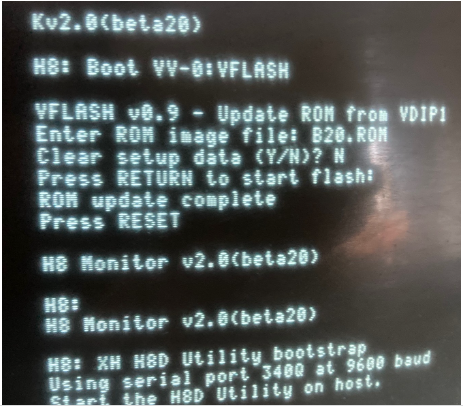
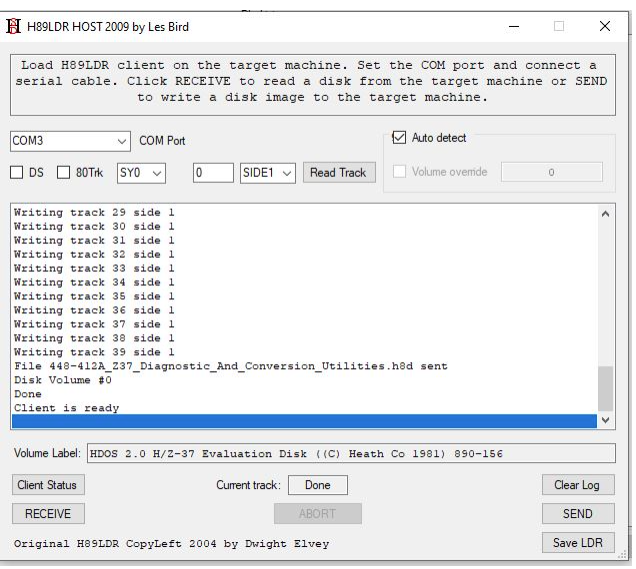
Norberto
To view this discussion on the web visit https://groups.google.com/d/msgid/sebhc/SN6PR01MB385588898420308A115426B6F7A09%40SN6PR01MB3855.prod.exchangelabs.com.
norberto.collado koyado.com
On Order:
814
Expected 16-Mar-23
Just around the corner.
To view this discussion on the web visit https://groups.google.com/d/msgid/sebhc/cb92d5ee-f8ea-43ec-97af-accab9c7a34fn%40googlegroups.com.
Glenn Roberts
Terry has begun experimenting with the V2DIP1 and so far there appear to be only minor differences. We may have to tweak our code to detect which module is in use. We should know more soon, meanwhile, as Norberto says, Mouser is expecting more devices next month
On Feb 16, 2023, at 2:28 AM, norberto.collado koyado.com <norberto...@koyado.com> wrote:
To view this discussion on the web visit https://groups.google.com/d/msgid/sebhc/BN7PR01MB38447E0D71E7C0818AB03B99F7A09%40BN7PR01MB3844.prod.exchangelabs.com.
Glenn Roberts
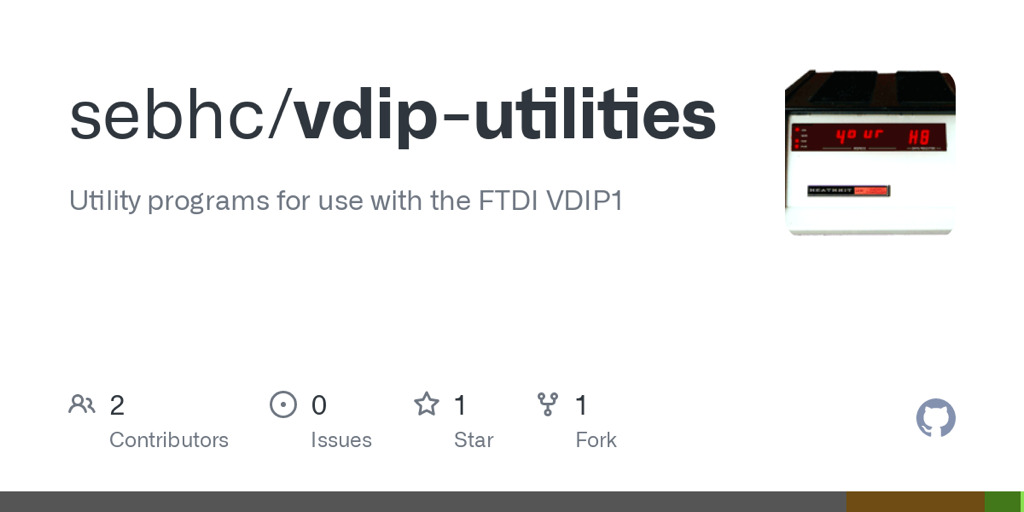 | |
See docs directory for documentation.
On Feb 16, 2023, at 12:34 AM, smb...@gmail.com <smb...@gmail.com> wrote:
Yeah, I just found one of the pages on the USB adapter board that described the VDIR and VGET commands.
To view this discussion on the web visit https://groups.google.com/d/msgid/sebhc/55d8bf7c-58b8-48d5-9da3-cdfdd7e46706n%40googlegroups.com.
Douglas Miller
I'm not sure I fully understand the scenario. The XH command already does the H17 initialization, so it should not be necessary to manually fake-boot the H17. Not sure if that unnecessary step is causing the problem. If there is a way to run the H8DUtility client on Linux, I could try and reproduce with the simulator (not sure how I get it to connect to a simulated serial port, though).
Keep in mind, that the bootstrap code puts "ready" in the display
(and prints to the terminal) and jumps to the downloaded routine.
The fact that the display says "ready" does not really mean
anything after that, unless the code crashed badly enough to
disable interrupts or corrupt the display memory.
To view this discussion on the web visit https://groups.google.com/d/msgid/sebhc/BN7PR01MB3844144FE507A0DE95F3D1B7F7A09%40BN7PR01MB3844.prod.exchangelabs.com.
Glenn Roberts
Ok thanks for checking Norberto. I’ll investigate
On Feb 16, 2023, at 2:26 AM, norberto.collado koyado.com <norberto...@koyado.com> wrote:
Glenn,
I’m using Monitor v2.0(beta30) and having same issue as you. I do get the “Ready” message on the H19 terminal, the H17 disk drive motor comes on, head loads, and activity LED lights, but then nothing further.
Douglas, I had to boot first from the H17 to get the same state as Glenn. I thought that was fixed.
<image001.png>
BKM: http://koyado.com/Heathkit/H89-SBC_H8D_Utility_files/H89-SBC-H8D_Utility.pdf
I tested way back with beta 20 and it worked. I cannot find such monitor anymore.
<image003.png>
<image004.png>
<image002.jpg>
To view this discussion on the web visit https://groups.google.com/d/msgid/sebhc/BN7PR01MB3844144FE507A0DE95F3D1B7F7A09%40BN7PR01MB3844.prod.exchangelabs.com.
Scott Baker
To view this discussion on the web visit https://groups.google.com/d/msgid/sebhc/41A219C0-9311-4C12-B4B5-A958957729A2%40gmail.com.
smb...@gmail.com
Glenn Roberts
On Feb 16, 2023, at 11:40 PM, smb...@gmail.com <smb...@gmail.com> wrote:
Also, is there a thread on the differences between VDIP1 and V2DIP-32? Looking at the datasheet, it appears they tried to make the hardware pin compatible (it seems possible to ignore the bottom-most 8-pins of the 32-pin part). That attention to hardware compatibility maybe means they also attempted to be software compatible? You mentioned "minor differences".
To view this discussion on the web visit https://groups.google.com/d/msgid/sebhc/7423709e-5510-41a0-a129-c9a1f0e558dan%40googlegroups.com.
Douglas Miller
Glenn also provides already-built images of the utilities, so
there's really no need to build them again.
To view this discussion on the web visit https://groups.google.com/d/msgid/sebhc/131B0DD0-7FE6-4EA3-B85D-F2E805C2F6B3%40gmail.com.
dwight
Sent: Wednesday, February 15, 2023 6:22 AM
To: se...@googlegroups.com <se...@googlegroups.com>
norberto.collado koyado.com
Dwight,
Can I get the schematics with your tunning and which opto to use?
Thanks,
Norberto
To view this discussion on the web visit https://groups.google.com/d/msgid/sebhc/SA1PR11MB6941CCE8003DF0371B9132EBA3A19%40SA1PR11MB6941.namprd11.prod.outlook.com.
norberto.collado koyado.com
I got never the V2DIP-32 to work as by default the parallel port fw is not loaded. You will need the adapter to program it to load the parallel port fw. That increases the overall price. If I find the parts, I can send to Terry.
Norberto
To view this discussion on the web visit https://groups.google.com/d/msgid/sebhc/131B0DD0-7FE6-4EA3-B85D-F2E805C2F6B3%40gmail.com.
Terry Smedley
norberto.collado koyado.com
Sent: Friday, February 17, 2023 8:23:01 AM
To: SEBHC <se...@googlegroups.com>
Terry Smedley
glenn.f...@gmail.com
I did a search on Octopart
https://octopart.com/search?q=vdip1¤cy=USD&specs=0
I think the only ones who have them seem to be OEM suppliers…
Utmel seems to have cornered the market. not sure the price means anything but if it does it’s no wonder they haven’t sold !
Do companies like this ever deal with the consumer market for bulk buys? I’d be happy to buy out a chunk of Decca’s stock at $4.39 a pop!
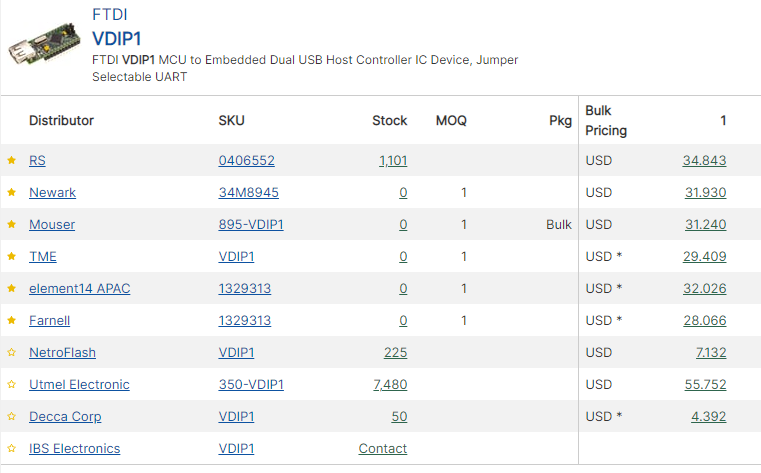
To view this discussion on the web visit https://groups.google.com/d/msgid/sebhc/SN6PR01MB3855D006575F41B9AEAB2A95F7A19%40SN6PR01MB3855.prod.exchangelabs.com.
smb...@gmail.com
norberto.collado koyado.com
Sent: Friday, February 17, 2023 1:38:31 PM
To: SEBHC <se...@googlegroups.com>
Subject: [sebhc] Re: Vinculum VDIP1, V2DIP1, and related
Mark Garlanger
To view this discussion on the web visit https://groups.google.com/d/msgid/sebhc/SN6PR01MB385517D2D6C0A44B4C98CEBDF7A19%40SN6PR01MB3855.prod.exchangelabs.com.
Scott Baker
To view this discussion on the web visit https://groups.google.com/d/msgid/sebhc/CAAjkm79QxK3bM6fyiksRxAXczdkDhjnoP%2B%3DT%2B9LoMUXnbh-1YQ%40mail.gmail.com.
norberto.collado koyado.com
Sent: Friday, February 17, 2023 4:32:53 PM
To: se...@googlegroups.com <se...@googlegroups.com>
Subject: Re: [sebhc] Re: Vinculum VDIP1, V2DIP1, and related
smb...@gmail.com
Glenn Roberts
On Mar 8, 2023, at 9:37 PM, smb...@gmail.com <smb...@gmail.com> wrote:
Terry, I need to validate that my Pinculum board works with a V2DIP1-48 module before I can consider it ready to hand off to others. Is your modified firmware available? The one that adds the blank line after DIR ? I can probably duplicate this given the IDE and source code, but it would be easier just to use what you already figured out, especially if you've sorted out anything else, such as mapping the pins to their VDIP1-compatible functions.
To view this discussion on the web visit https://groups.google.com/d/msgid/sebhc/c344f0a1-86db-40f4-8c7a-b4e27b0b45b6n%40googlegroups.com.
Terry Smedley
norberto.collado koyado.com
Scott,
I have two new VDIP1 modules which I flashed a different FW to test the second USB pot. But I couldn’t flash it back with the default FW. I can send both to you and I just need one back running the correct FW, if you can recover them.
Norberto
To view this discussion on the web visit https://groups.google.com/d/msgid/sebhc/b0f90356-76b1-46a5-9c76-30fe0aaaa359n%40googlegroups.com.
smb...@gmail.com
glenn.f...@gmail.com
Norberto: if you’ve “bricked” your VDIP1 modules we may need the VPROG1 programmer to reprogram them
https://ftdichip.com/products/vprog-1/
or the ZIF equivalent:
Terry may know of other ways to do this?
To view this discussion on the web visit https://groups.google.com/d/msgid/sebhc/SN6PR01MB385597455C3A68C12DD5FCABF7B59%40SN6PR01MB3855.prod.exchangelabs.com.
Terry Smedley
** cmd_dirt
**
** Show file create, modify and access times.
**
** Parameters: none
** Returns: MON_SUCCESS, MON_ERROR_INVALID_FILENAME name is not a valid file name,
** MON_ERROR_CMD_FAILED could not show time information for file.
** Comments:
*/
unsigned char cmd_dirt()
{
char cr = 0x0d, sp = ' ';
file_context_t fileFind;
unsigned char result = MON_ERROR_CMD_FAILED;
void *findHandle;
unsigned short date;
unsigned char i;
// filename specified:
monReadFileName(1);
// purge until CR
monReadCr();
result = monValidateFileName(1);
if (result == MON_SUCCESS)
{
// We have a valid parameter.
if (fat_dirTableFind(fatContext, &fileFind, (char *) param1Data) == FAT_OK)
{
-----------------------------------------------------------------------------------------------------------------------------------
monWrite(&cr, 1);
// end of extensive modification by TAS
-----------------------------------------------------------------------------------------------------------------------------------
monWrite(&sp, 1);
date = fat_dirEntryTime(&fileFind, FAT_DIRENTRYTIME_CREATE_TIME);
monAddNumberToConsole((unsigned char *) &date, 2);
date = fat_dirEntryTime(&fileFind, FAT_DIRENTRYTIME_CREATE_DATE);
monAddNumberToConsole((unsigned char *) &date, 2);
date = fat_dirEntryTime(&fileFind, FAT_DIRENTRYTIME_ACCESS_DATE);
monAddNumberToConsole((unsigned char *) &date, 2);
date = fat_dirEntryTime(&fileFind, FAT_DIRENTRYTIME_MODIFY_TIME);
monAddNumberToConsole((unsigned char *) &date, 2);
date = fat_dirEntryTime(&fileFind, FAT_DIRENTRYTIME_MODIFY_DATE);
monAddNumberToConsole((unsigned char *) &date, 2);
monWrite(&cr, 1);
}
else
{
result = MON_ERROR_CMD_FAILED;
}
}
else
{
result = MON_ERROR_INVALID_FILENAME;
}
return result;
}
Glenn Roberts
On Mar 9, 2023, at 10:19 AM, Terry Smedley <terry....@gmail.com> wrote:
Here is the updated V2DAP firmware for the V2DIP1-48 module.
To view this discussion on the web visit https://groups.google.com/d/msgid/sebhc/bf8a4fdf-6967-427f-9ab3-4af08dd111f5n%40googlegroups.com.
<V2DAP.rom>
smb...@gmail.com
Douglas Miller
That is an extended CP/M 3 .SYS file. The basic format is described in the CP/M 3 System Guide Appendix D. I thought I had added documentation of this in the Monitor ROM document, but it is not there yet.
The VDIP boot command allows you to specify the name of the file to run, so you don't need to force anything to be named "defboot.sys". Have a look at the ROM documentation at https://github.com/durgadas311/MmsCpm3/blob/master/rom/newmon/doc/H8-Monitor-2.pdf and let me know specifically what you want to do. There are SYS files (standalone commands) in the https://github.com/durgadas311/MmsCpm3/tree/master/rom/newmon/bin folder (mixed in with other files).
Note the VDIP "booting" is only available on the new Monitor ROMs (32K EEPROM new CPU boards).
To view this discussion on the web visit https://groups.google.com/d/msgid/sebhc/8cee1c22-44d1-447d-8478-485738a71301n%40googlegroups.com.
smb...@gmail.com
norberto.collado koyado.com
I realize the 32K ROM also has a compactflash boot loader built into it, but I'm assuming that's for the old 8255-based compactflash board? or is it for the new direct CF board?
It is for the new direct CF board. If you have a Z80 you can boot MMS CP/M3 without any issues.
To view this discussion on the web visit https://groups.google.com/d/msgid/sebhc/28c03cc7-f04c-4536-8d9d-4f4409f79f17n%40googlegroups.com.
smb...@gmail.com
norberto.collado koyado.com
I will need Rick help to get Heath HDOS and Heath CP/M booting on such CF card. The method that he put together is to support the Heathkit 8080A CPU board as an alternative to floppy disks. Next steps is for me to enable him to get an 8080A 32K board to update his boot-strap to work on such configuration for both OS’s.
For now we only have CP/M3 on the Z80 32K board working on such CF card board.
To view this discussion on the web visit https://groups.google.com/d/msgid/sebhc/e6611dc2-36c8-4cbc-aab6-03de01089357n%40googlegroups.com.
Glenn Roberts
On Mar 10, 2023, at 1:57 AM, norberto.collado koyado.com <norberto...@koyado.com> wrote:
To view this discussion on the web visit https://groups.google.com/d/msgid/sebhc/SN6PR01MB3855D3CA276B9CEFA4B43D19F7BA9%40SN6PR01MB3855.prod.exchangelabs.com.
Douglas Miller
Just to expand on all this, and clarify, the .SYS file format is not restricted to CP/M - it is just the origin format chosen. The files are "standalone programs" (or OS images), and as such are not restricted to any particular OS. Also note, these .SYS files may be booted from either the VDIP or the WizNET. The same format and same file may be used on either without conversion.
I have a java program for creating .SYS standalone programs. This
requires the CP/M toolset (or the Linux zmac/ld80 tools) because
it requires the .SPR relocatable format. However, the programs
being created have no dependency on CP/M (they are "standalone"
and thus have no OS dependencies). Note that this toolset supports
the Software Toolworks C/80 compiler, allowing the C language to
be used, in addition to RMAC/M80 assembly language. To re-iterate,
using CP/M tools to build programs does not require that the
resulting program be run under CP/M. I've been using the CP/M
tools to build HDOS programs, as well as standalone programs.
Note that HDOS .ABS files are not required to be located (ORGed) at 2280H, but it seems that most of them are. If one does not have the source code, it becomes difficult to convert these to .SYS files (ORGed above the normal 2280H, recommended 3000H). Also, "normal" HDOS programs cannot be run standalone as they (typically) require HDOS syscalls.
As background, this originally started as a way to recover from a common problem on CP/M 3: rebuilding CPM3.SYS and finding it had a mistake and was unbootable. This way, a backup copy of a working CPM3.SYS can be used to recover, as you can boot directly into CP/M 3 using the WizNET or VDIP and then repair your broken CPM3.SYS file (disk). This scheme just also allows almost anything to be booted, opening up "standalone utilities" for test and diagnosis. We even have a "core dump" utility that - while not perfect - does give a decent dump of memory which has been handy on several occasions for debugging problems.
To view this discussion on the web visit https://groups.google.com/d/msgid/sebhc/4441B9C8-CDB3-453A-9309-06700A3C18F2%40gmail.com.
Douglas Miller
Also note that there is already a standalone program that will
allow you to use H8D images on the USB drive on the H17. You can
create disks or save disks to H8D images.
https://github.com/durgadas311/MmsCpm3/blob/master/rom/newmon/bin/vh8dutil.sys.
You put this program on the you USB drive and boot it. If you are
creating H17 disks, you put the H8D images you want on the USB
stick as well.
To view this discussion on the web visit https://groups.google.com/d/msgid/sebhc/4441B9C8-CDB3-453A-9309-06700A3C18F2%40gmail.com.
glenn.f...@gmail.com
So a while ago we had a discussion about how the ‘XH’ command in the new ROM wasn’t working with H8DUtility – there was a synchronization issue with the H89LDR3 code. I said I’d take a look. Currently the ‘XH’ command simply saves you from typing in the short server program from the keypad – you still have to run H8DUtility and download the full server. I did take a look and decided that what the ‘XH’ command should really do is simply run the full server – saves the step of downloading (which is where we are having issues). Then you’d be able to type ‘XH’ and the H8DUtility would immediately indicate “client ready”.
This was not as easy as I thought it would be. I tried moving the full server code to a .SYS file (for test purposes; if it works Doug would fold the code into the ROM) but it’s ORGed at 42.200 and that conflicts with the ROM code working space, so it would have to be ORGed at more like 60.000. It’s doable but has been a little frustrating. So far my attempts have failed.
So, stepping back: all of this is really only necessary for machines that have the Z80 4.0 and new ROM but don’t have a USB interface. If you have the VDIP device it’s much better to just run vh8dutil.sys, as Doug suggests.
I don’t have much of a sense for who has what but I’m going to assume for now that there are few users who need the ‘XH’/H89LDR incompatibility to be fixed right now?
For now I’d say just boot vh8dutil.sys as doug suggests. It’s a great way to create and archive disks and really the kind of approach we should focus on moving forward when we can.
Fixing this should remain somewhere on the to do list, but right now I can’t take it further…
To view this discussion on the web visit https://groups.google.com/d/msgid/sebhc/8d398953-2399-6644-bd6a-c9221edd286f%40gmail.com.
smb...@gmail.com
smb...@gmail.com
smb...@gmail.com
glenn.f...@gmail.com
Long note: if you use (or think you might want to use) flash drives to read/write from your H8/H89 this may be of interest.
It’s been some time since we started this discussion so here’s an update:
Years ago we adopted the FTDI “VDIP1” USB host module as our “standard” way to read/write files from/to USB flash drives. The VDIP1 was designed specifically to provide a USB host function for small or embedded devices (e.g. rPi, Arduino) but it is also ideal for older 8 bit computers. I wrote a set of “Vinculum Utilities” that let us list flash drive contents, copy files back and forth and use the hierarchical directory structure of the flash drive. The general description of my work is in this REMarks article:
REMarks Issue 6 - 14 February 2022.pdf (sebhc.github.io)
The software repository is on GitHub:
sebhc/vdip-utilities: Utility programs for use with the FTDI VDIP1 (github.com)
Norberto has built this interface into several of his recent boards including the DUART/USB daughterboard for the Rev 4 CPU board but also his H17 controller boards and perhaps others.
It appears that the VDIP1 module (introduced around 2007 I think?) is now at the end of life. DigiKey lists zero in stock. Octopart lists zero in stock at all “authorized distributors”. Mouser says the expect to get a dozen of them by October, but who knows. FTDI lists it as “out of stock.”
The point is we need a new solution.
The recommended progression is to the V2DIP1-48. These are also a little hard to find but I believe that’s a supply chain/distribution issue. DigiKey currently has 73 in stock. You can also purchase directly from FTDI. This module is based on a newer version of the processor (VNC2) and (as far as I can tell) is in production and a supported product, just a bit backlogged.
But the module itself has one noteworthy physical change: it uses header style square pins (not sure what you call those?) vs. machined pins, so it *wont* fit into a machined socket. It does fit into a dual wipe socket fine.
There is also a minor change that somehow crept into the “VDAP” firmware that unfortunately changes the output format for the DIRectory function which “breaks” some of my Vinculum utility programs.
Also, while the old VDIP1 came pre-programmed with the VDAP firmware the new device does not, therefore it is necessary to program it. This is unfortunate. you can either purchase the programmer (“VNC2 Debug Module, DigiKey part # 768-1052-ND) or use a UART interface to program the software. The UART interface requires an appropriate USB to serial interface such as the FTDI TTL-232R.
Terry Smedley took the time to modify the source code for the VDAP software to make it produce the same format output as the previous version and shared his ROM code (email below). The good news is that I have been able to use the UART approach to program the device using Terry’s modified firmware and all is well. The new device seems to work exactly like the VDIP1 in all the test cases I’ve tried!
I will expand on this writeup at some point and document this as an update to my previous REMarks article, but for now just wanted everyone to know that we are “back in business” on the VDIP/USB front.
In the near term if you want to get started feel free to contact me (probably off list) and I can help you get set up with a programmed V2DIP1-48 device, and if you’re building out any of the boards mentioned please make sure you use a dual wipe (not machined) 24-pin socket for the VDIP module.
Thanks!
To view this discussion on the web visit https://groups.google.com/d/msgid/sebhc/bf8a4fdf-6967-427f-9ab3-4af08dd111f5n%40googlegroups.com.
